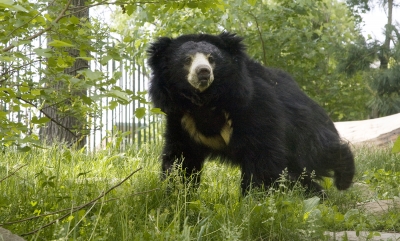
Sloth bears are a bit misleading by name. They are not related to sloths, and they are not slow moving. In fact, they’re agile bears that can run faster than a human and will attack if surprised. It was a European zoologist, George Shaw, who named the sloth bear for its long, thick claws and unusual teeth. He thought that the bear was related to the tree sloth due to these features. Sloth bears sometimes hang upside down on tree branches, much like a tree sloth.
The sloth bear is a bit messy in appearance. It has long, rough, unruly hair around its ears, shoulders, and neck that is cinnamon to dark brown in color. The pale muzzle and a flexible nose sniff out interesting smells. The sloth bear often has a white patch of fur on its chest in the shape of a Y, O, or U. With a stocky body and powerful legs, this medium-size bear is able to climb trees. The sloth bear cannot pull in its claws like a cat’s, so it looks a bit awkward when walking.
Sloth bears adapt well to many different habitats. They live in the hot, dry grasslands and forests of South Asia and the Indian subcontinent. Does having a thick and shaggy coat seem odd for this environment? That coat protects them from being bitten by their favorite food—termites! It also gives sloth bear cubs something to grip when their mothers carry them on their backs.
These bears are unusual because they do not hibernate like some bears. They often sleep in caves and near rivers when available. Sloth bears tend to be nocturnal when living around humans. But without human disturbance nearby, they are often active during the day.
The sloth bear has a nose for sniffing out food but it cannot see or hear as well as other bears. It is not aggressive, but it will defend itself against tigers, leopards, and other bears by standing on its back legs and using its teeth and claws.
While it might have a “bear” of an appetite, the sloth bear has more in common with an anteater than other bears. Even though it is omnivorous and dines on fruit when available, the sloth bear also eats termites and ants. As an adaptation for this creepy-crawly diet, the bear has few hairs on its nose and can open and close its nostrils as needed. This keeps bugs from crawling up the bear’s nose while it eats!
Large, thick 3-inch (8-centimeter) claws come in handy for ripping apart termite nests in soil, old logs, or trees. This is a noisy activity. In fact, sloth bears are well known for being noisy bears, especially while they eat. A large gap between the upper teeth makes the perfect space for sucking up termites. Like vacuum cleaners, the bears’ lips and tongue create a powerful suction and loud slurping, sucking sounds. They also eat honey, sugarcane, flowers, eggs, grubs, and carrion.
Credit : San Diego Zoo
Picture Credit : Google




